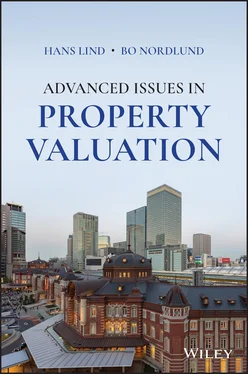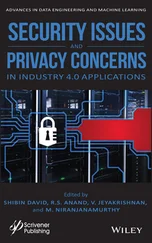There are also other economic (value) concepts than market value and investment value that may be relevant in different situations. Examples of such value concepts are acquisition cost/‐value, replacement cost/‐value or long‐term values of different kinds. We will further discuss such value concepts in Chapters 5and 6.
The International Valuation Standards defines market value as follows (IVSC 2019 , p. 18):
Market value is the estimated amount for which an asset or liability should exchange on the valuation date between a willing buyer and a willing seller in an arm's length transaction after proper marketing where the parties had each acted knowledgeably, prudently, and without compulsion.
This definition is also the official one in the United Kingdom and accepted by RICS. In the RICS Valuation – Global standards (RICS 2019 ), the standards from IVSC are included in full as Part 6 of that book.
The US Appraisal Institute presents the following definition (Appraisal Institute 2013 , p. 58):
The most probable price, as of a specified date, in cash or in terms equivalent to cash, or in other precisely revealed terms, for which the specified property rights should sell after reasonable exposure in a competitive market under all conditions requisite to a fair sale, with the buyer and seller each acting prudently, knowledgably, and for self‐interest, and assuming that neither is under undue duress.
Looking closer at these definitions, some common elements can be found:
A date of valuation (a measurement date).
Reference to the amount that the property should exchange for after proper marketing (reasonable exposure, in an orderly transaction).
Reference to buyers and sellers acting knowledgably and prudently: this is discussed in Section 2.4.
Reference to a willing buyer/willing seller: this is discussed in Section 2.5.
But there are also some differences:
The IVSC/RICS definition refers to ‘the estimated amount’ while the US definition refers to ‘the most probable price’ (discussed in Section 2.4).
The US definition refers to ‘a competitive market’ but there is no such reference in the IVSC one: this is discussed in Section 2.6).
Another problem that will be discussed in this chapter is the relation between turnover and market price, and whether turnover in some way should be included in the definition ( Section 2.8). In both the standards, there is also a discussion about ‘highest and best use’ and this will be discussed in Section 2.9.
2.3 Criteria for a Good Definition: Clear, Measurable, Concise and Relevant
The point of making a definition is to clarify a concept and therefore the words used in the definition must be clear in the sense that they are interpreted and applied in a similar way by different actors . 1 If a word is vague, there might be disagreement about whether it is correct to apply it in a specific situation. Additional explanations may sometimes be needed to make sure that the readers will apply the term in the same way and such clarifications can, for example, be found in IVSC (2019 , pp. 18–20).
A second criterion for a good definition is that it refers to things that are measurable , at least in principle. If valuers disagree, it should at least in a number of circumstances be possible to find data that indicate which estimate is closer to the truth. RICS (2019 , p. 2) states that ‘Consistency, objectivity and transparency are fundamental to building and sustaining public confidence and trust in valuation’. Objectivity in the context of a definition could be interpreted as that there exist data/evidence that substantiate at least a claim that the market value is closer to A than to B.
A definition should also be concise and not include terms that do not add any further content to the definition. This condition is sometimes referred to as Occam´s razor, i.e. unnecessary components in the definition should deleted.
The final condition for a good definition of market value is that the definition should lead to a concept that is relevant in the context where the term normally is used . A definition of market value should be such that market value ‐ so defined ‐ will be of interest for potential buyers and sellers thinking about a future transaction, or for measuring the wealth of a company in the balance sheet.
2.4 Problem 1: ‘Estimated Price’ or ‘Most Probable Price’?
As there always are uncertainty about the price that is possible to fetch when selling a specific property at a specific point in time, the formulation ‘most probable price’ seems to be the best as this uncertainty then is clear. In IVSC (2019 , p. 18), ‘the estimated amount’ is also explained in terms of ‘the most probable price reasonably obtainable in the market’, even though it is not clear what ‘reasonably obtainable’ adds to the formulation.
This does not, however, solve all problems. Suppose that there are 10 observations from recent transactions of very similar properties. Should the most probable price refer to the mean value or to the median value? If the observations are skewed, there can be rather large differences between the mean and the median. As valuers usually are suspicious against ‘outliers’, the median should perhaps be the most relevant concept.
The next question is how ‘most probable’ should be interpreted in the context of property valuation. As discussed in Lind (1998 ), there are at least two definitions of probability, or two different ways of looking at the concept of probability.
The first is the frequency interpretation of probability. In this interpretation, saying, for example, that the probability is 1/6 to get the number 3 when throwing a dice would simply mean that if the dice is thrown a large number of times, then the result would be a number 3 in 1/6 of the throws.
This interpretation is, however, rather meaningless in a real estate valuation context as it is not practically possible to sell the same property a large number of times during a short period of time. Even in a rather homogenous market, there is a limited number of transactions. Defining the most probable price as the average of the observed prices would be the same as saying that the probability of getting a number 3 is not 1/6 because the frequency of getting number 3 differed from 1/6 in the first 10 throws. With a frequency interpretation of probability, it would therefore not be possible to present convincing evidence whether a certain price is the most probable or not.
A second interpretation of probability is the logical interpretation, where probability measures the degree of confidence that is rationally justified by the available evidence. This interpretation seems very suitable in a property valuation context. When a valuer, for example, asserts that the value is 100, it would in this interpretation mean that given the available evidence it is more rational to believe in a price around 100 than to believe in a price around 90 or around 110. Controversies about the value of a specific property can also typically be seen as controversies about the interpretation of the relevant evidence. A valuation method is from this perspective a method to collect and analyse evidence in order to arrive at rational belief about what the price will be if the property is sold.
The conclusion in this section is then that the formulation ‘most probable price’ is the best one and that it can be explained further by saying that it refers to the price for which there is the strongest arguments, or for which there is the strongest evidence.
2.5 Problem 2: Shall the Definition Refer to a Competitive Market?
Читать дальше












